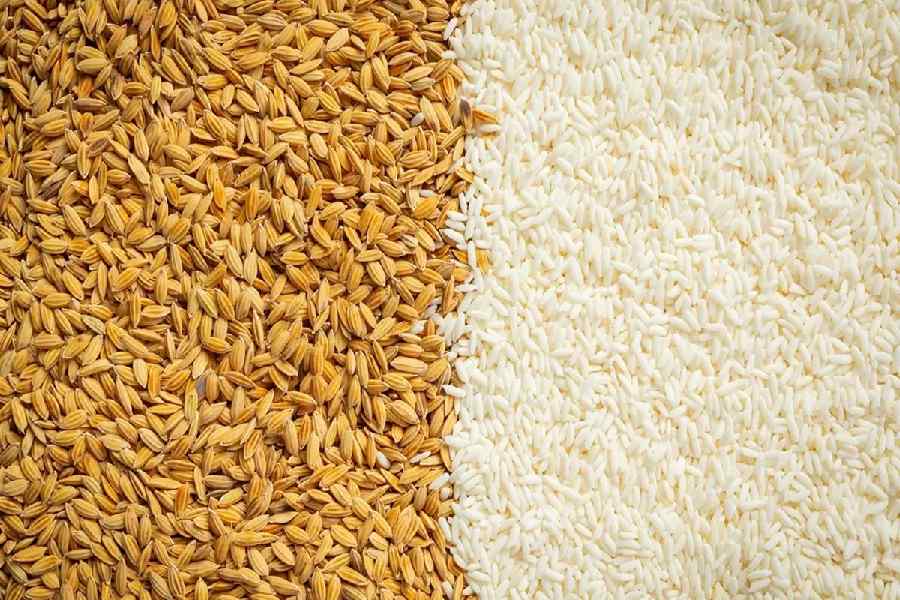India's rice and wheat varieties have lost essential health-friendly minerals and accumulated toxic elements, scientists have cautioned, flagging research showing a decline in grain nutrient make-up that they say has remained largely neglected.
The scientists have found that the concentrations of essential elements including calcium, iron and zinc in grains from present-day cultivated rice and wheat varieties are between 19 per cent to 45 per cent lower than in grains from the 1960s.
The study led by scientists in Bengal has also shown that rice grains from some landmark varieties cultivated across the country have nearly 16-fold higher arsenic and four-fold higher chromium levels than in the grains from the 1960s.
However, present-day wheat grains have lower levels of arsenic and chromium than wheat from the 1960s, according to the study just published in the journal Scientific Reports. Arsenic and chromium are potentially toxic elements with detrimental health effects.
Their findings suggest that while the Green Revolution enhanced yields and helped India attain self-sufficiency in food, the dietary values of rice and wheat — the country’s most popular carbohydrate staples — have deteriorated.
“Nobody imagined this would happen,” said Biswapati Mandal, professor of soil science at the Bidhan Chandra Krishi Vidyalaya, Mohanpur, Bengal. “The Green Revolution was focused on increasing yields and breeding varieties that were tolerant or resistant to pests and other stresses — no one cared much about the elemental make-up of the grains.”
Mandal and his colleagues from other agricultural research centres and a scientist at the National Institute of Nutrition, Hyderabad, have expressed concern that the depletion of essential minerals might have adverse health impacts on the population.
Calcium is needed for bone formation, iron for haemoglobin and zinc is important for immunity and reproductive and neurological health.
The researchers examined the elemental make-up of grains from rice and wheat varieties from the 1960s until the 2010s, picking the so-called landmark or the best varieties widely cultivated.
They found that the average calcium levels in rice cultivated in the 2000s were 45 per cent lower than in rice from the 1960s. Iron levels were 27 per cent lower and zinc 23 per cent lower. Wheat from the 2010s had 30 per cent less calcium, 19 per cent less iron and 27 per cent less zinc than wheat from the 1960s.
Mandal has alerted the Indian Council of Agricultural Research (ICAR) about the research results and urged the apex agency to begin screening major food crops including rice and wheat varieties for their elemental make-up before release for cultivation.
A senior ICAR scientist who requested not to be named said it would be premature to extrapolate the research results to all rice and wheat varieties grown across the country.
“We have released over 1,400 varieties over the past decades — the study has sampled only 16 varieties of rice and 18 varieties of wheat,” the scientist said.
The first hints of a historical shift in the elemental make-up of rice and wheat grown in India emerged in 2021 when Mandal’s student Sovan Debnath noted in a preliminary study that present-day varieties of both cereals were deficient in iron and zinc.
“For reasons that remain unclear, the plants’ capacity to absorb such essential minerals from soil has eroded over the decades,” said Debnath, a soil scientist currently at the Central Agroforestry Research Institute, Jhansi. “Why exactly this has happened is a question for molecular biologists.”
In the new study, the scientists measured changes in multiple essential elements and toxic elements such as arsenic and chromium. The average arsenic level in rice from the 2000s is nearly 16-fold higher than in rice from the 1960s, while the average chromium level is nearly four-fold higher.
Debnath said differences in the growing ecology of rice and wheat might help explain the increased uptake of arsenic and chromium in rice over the years.
A scientist at the ICAR’s National Rice Research Institute, Cuttack, said the crop breeding community had been involved in efforts to develop biofortified varieties. Examples are rice varieties that contain high levels of protein and zinc, the scientist said. “The earlier efforts were aimed at food security, we’re now pursuing nutritional security.”
Crop science researchers have earlier cautioned about the adverse effects that accompanied the Green Revolution — excessive use of chemical fertilisers and pesticides, a focus on rice and wheat away from traditional coarse grain cereals, and depleting groundwater reserves in northern India.











